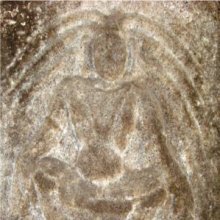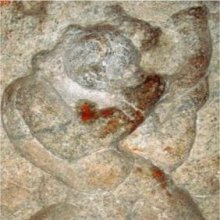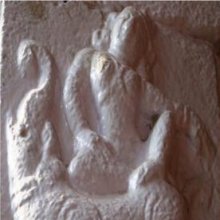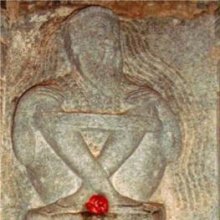Mukhamandapa, Mukhamaṇḍapa, Mukha-mandapa, Mukhamamdapa: 4 definitions
Introduction:
Mukhamandapa means something in Hinduism, Sanskrit, the history of ancient India. If you want to know the exact meaning, history, etymology or English translation of this term then check out the descriptions on this page. Add your comment or reference to a book if you want to contribute to this summary article.
Images (photo gallery)
(+13 more images available)
In Hinduism
Vastushastra (architecture)
Source: Shodhganga: Temples of Salem region Up to 1336 ADMukhamaṇḍapa (मुखमण्डप) is a small pavilion or porch constructed in front of the doorway of the temple. As this forms the part of the façade of the temple, this pavilion is called by the name mukhamaṇḍapa (mukha- face + maṇḍapa- pavilion). Mukhamaṇḍapa is a regular feature of the Dravidian temple architecture.
Mukhamaṇḍapa is a small porch built on the same plinth (adhiṣṭhāna) on which the temple is built. It is supported by four pillars. Of these pillars, two are in the front and two are at the back. The pillars on the backside are placed adjacent to the wall of the temple.
Source: OpenEdition books: Architectural terms contained in Ajitāgama and RauravāgamaMukhamaṇḍapa (मुखमण्डप) refers to “pavilion attached to the main face of a prāsāda §§ 3.34, 39; 4.9, 13, 16, 22, 28, 37; 5.2, 14.”.—(For paragraphs cf. Les enseignements architecturaux de l'Ajitāgama et du Rauravāgama by Bruno Dagens)

Vastushastra (वास्तुशास्त्र, vāstuśāstra) refers to the ancient Indian science (shastra) of architecture (vastu), dealing with topics such architecture, sculpture, town-building, fort building and various other constructions. Vastu also deals with the philosophy of the architectural relation with the cosmic universe.
India history and geography
Source: Cologne Digital Sanskrit Dictionaries: Indian Epigraphical GlossaryMukha-maṇḍapa.—Tamil muga-maṇḍaka (SITI), the front hall in a temple; cf. mahāmaṇḍapa. Note: mukha-maṇḍapa is defined in the “Indian epigraphical glossary” as it can be found on ancient inscriptions commonly written in Sanskrit, Prakrit or Dravidian languages.

The history of India traces the identification of countries, villages, towns and other regions of India, as well as mythology, zoology, royal dynasties, rulers, tribes, local festivities and traditions and regional languages. Ancient India enjoyed religious freedom and encourages the path of Dharma, a concept common to Buddhism, Hinduism, and Jainism.
Languages of India and abroad
Kannada-English dictionary
Source: Alar: Kannada-English corpusMukhamaṃḍapa (ಮುಖಮಂಡಪ):—[noun] = ಮುಖಮಂಟಪ [mukhamamtapa].
Kannada is a Dravidian language (as opposed to the Indo-European language family) mainly spoken in the southwestern region of India.
See also (Relevant definitions)
Partial matches: Mukha, Mandapa.
Full-text: Mahamandapa, Ardhamandapa, Antarala-mandapa, Antarala, Dhvajastambha, Khanda, Trikhandakara, Mandapa, Varadaraja.
Relevant text
Search found 14 books and stories containing Mukhamandapa, Mukhamaṇḍapa, Mukha-mandapa, Mukhamamdapa, Mukha-maṇḍapa, Mukhamaṃḍapa; (plurals include: Mukhamandapas, Mukhamaṇḍapas, mandapas, Mukhamamdapas, maṇḍapas, Mukhamaṃḍapas). You can also click to the full overview containing English textual excerpts. Below are direct links for the most relevant articles:
Kashyapa Shilpa-shastra (study) (by K. Vidyuta)
Pallava period (Social and Cultural History) (by S. Krishnamurthy)
Rathas (monolithic cut-out temples) < [Chapter 2 - Origin of Sculptural Art—Its Development and Scheme]
Dressing style of Upper-class men < [Chapter 4 - Material Culture of the People]
House, Palace and Fort (of the Pallavas) < [Chapter 4 - Material Culture of the People]
Middle Chola Temples (by S. R. Balasubrahmanyam)
Temples in Sivapuram < [Chapter II - Temples of Rajaraja I’s Time]
Temples in Brahmadesam (S.A.) < [Chapter IV - Temples of Rajendra I’s Time]
Mahamandapa and Mukhamandapa < [Tanjavur/Thanjavur (Rajarajesvaram temple)]
Temples in and around Madurantakam (by B. Mekala)
Appendix 3: Thiru Aatcheeswarar Temple Layout
Appendix 2: Thiru Venkateswara (Kadapperi) Temple Layout
Atcheeswarar Temple at Acharapakkam < [Chapter 4 - Prominent Temples in Madurantakam Taluk]
Later Chola Temples (by S. R. Balasubrahmanyam)
Temples in Sendamangalam < [Part II - Contributions of the Later Pallavas to the Chola-Pallava Phase]
Temples in Achyutamangalam < [Chapter XII - Temples of Kulottunga III’s Time]
Appendix 3: Kalattur < [Chapter VIII - Temples of Rajaraja II’s Time]
Early Chola Temples (by S. R. Balasubrahmanyam)
Temples in Erumbur (Urumur) < [Chapter II - Temples of Parantaka I’s Time]
Table III. Inscriptions on pillars in the mandapa in front of the southern shrine < [Chapter XIII - Prasada: Component Parts]
Temples In Punjai < [Chapter X - Historical Survey]
Related products






